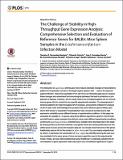Por favor, use este identificador para citar o enlazar a este item:
http://hdl.handle.net/10261/139499COMPARTIR / EXPORTAR:
 SHARE SHARE
 CORE
BASE CORE
BASE
|
|
| Visualizar otros formatos: MARC | Dublin Core | RDF | ORE | MODS | METS | DIDL | DATACITE | |

| Título: | The challenge of stability in high- throughput gene expression analysis: comprehensive selection and evaluation of reference genes for BALB/c mice spleen samples in the leishmania infantum infection model |
Autor: | Hernandez-Santana, Yasmina; Ontoria, Eduardo; González-García, Ana C.; Quispe-Ricalde, M. Antonieta; Larraga, Vicente CSIC ORCID ; Valladares, Basilio; Carmelo, Emma | Fecha de publicación: | 26-sep-2016 | Editor: | Public Library of Science | Citación: | PLoS ONE 11(9): e0163219 (2016) | Resumen: | The interaction of Leishmania with BALB/c mice induces dramatic changes in transcriptome patterns in the parasite, but also in the target organs (spleen, liver…) due to its response against infection. Real-time quantitative PCR (qPCR) is an interesting approach to analyze these changes and understand the immunological pathways that lead to protection or progression of disease. However, qPCR results need to be normalized against one or more reference genes (RG) to correct for non-specific experimental variation. The development of technical platforms for high-throughput qPCR analysis, and powerful software for analysis of qPCR data, have acknowledged the problem that some reference genes widely used due to their known or suspected “housekeeping” roles, should be avoided due to high expression variability across different tissues or experimental conditions. In this paper we evaluated the stability of 112 genes using three different algorithms: geNorm, NormFinder and RefFinder in spleen samples from BALB/c mice under different experimental conditions (control and Leishmania infantum-infected mice). Despite minor discrepancies in the stability ranking shown by the three methods, most genes show very similar performance as RG (either good or poor) across this massive data set. Our results show that some of the genes traditionally used as RG in this model (i.e. B2m, Polr2a and Tbp) are clearly outperformed by others. In particular, the combination of Il2rg + Itgb2 was identified among the best scoring candidate RG for every group of mice and every algorithm used in this experimental model. Finally, we have demonstrated that using “traditional” vs rationally-selected RG for normalization of gene expression data may lead to loss of statistical significance of gene expression changes when using large-scale platforms, and therefore misinterpretation of results. Taken together, our results highlight the need for a comprehensive, high-throughput search for the most stable reference genes in each particular experimental model. | Descripción: | 16 p.-4 fig.-3 tab. | Versión del editor: | http://dx.doi.org/10.1371/journal.pone.0163219 | URI: | http://hdl.handle.net/10261/139499 | DOI: | 10.1371/ journal.pone.0163219 | ISSN: | 1932-6203 | E-ISSN: | 1932-6203 |
| Aparece en las colecciones: | (CIB) Artículos |
Ficheros en este ítem:
| Fichero | Descripción | Tamaño | Formato | |
|---|---|---|---|---|
| PLOS_ONE_Larraga V._2016.pdf | Artículo principal | 5,26 MB | Adobe PDF |  Visualizar/Abrir |
CORE Recommender
PubMed Central
Citations
6
checked on 10-abr-2024
WEB OF SCIENCETM
Citations
8
checked on 23-feb-2024
Page view(s)
279
checked on 23-abr-2024
Download(s)
405
checked on 23-abr-2024

